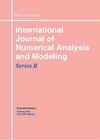带有 CTL 免疫反应和延迟的 HIV-1 感染模型的动力学分析
IF 0.7
4区 数学
Q1 MATHEMATICS
International Journal of Numerical Analysis and Modeling
Pub Date : 2024-06-01
DOI:10.4208/ijnam2024-1022
引用次数: 0
摘要
在本文中,我们严格分析了一个具有 CTL 免疫反应和三个时间延迟(分别代表潜伏期、病毒产生期和免疫反应延迟)的 HIV-1 感染模型。我们首先证明了该模型解的实在性和有界性。对于该模型,基本繁殖数 $R_0$ 和免疫产生数 $R_1$已经确定。此外,我们还证明了该模型有三个平衡态,即无感染平衡态 $E_0、无免疫反应的感染平衡态 $E_1$ 和有免疫反应的感染平衡态 $E_2$。通过应用波动雷玛和李亚普诺夫函数,我们证明了 $E_0$ 和 $E_1$ 的全局稳定性只与 $R_0$ 和 $R_1$ 有关。此外,我们还给出了霍普夫分岔存在的条件。最后,我们进行了一些数值模拟来说明理论结果。本文章由计算机程序翻译,如有差异,请以英文原文为准。
Dynamics Analysis of HIV-1 Infection Model with CTL Immune Response and Delays
In this paper, we rigorously analyze an HIV-1 infection model with CTL immune
response and three time delays which represent the latent period, virus production period and
immune response delay, respectively. We begin this model with proving the positivity and boundedness of the solution. For this model, the basic reproduction number $R_0$ and the immune
reproduction number $R_1$ are identified. Moreover, we have shown that the model has three equilibria, namely the infection-free equilibrium $E_0,$ the infectious equilibrium without immune
response $E_1$ and the infectious equilibrium with immune response $E_2.$ By applying fluctuation
lemma and Lyapunov functionals, we have demonstrated that the global stability of $E_0$ and $E_1$ are only related to $R_0$ and $R_1.$ The local stability of the third equilibrium is obtained under four
situations. Further, we give the conditions for the existence of Hopf bifurcation. Finally, some
numerical simulations are carried out for illustrating the theoretical results.
求助全文
通过发布文献求助,成功后即可免费获取论文全文。
去求助
来源期刊
CiteScore
2.10
自引率
9.10%
发文量
1
审稿时长
6-12 weeks
期刊介绍:
The journal is directed to the broad spectrum of researchers in numerical methods throughout science and engineering, and publishes high quality original papers in all fields of numerical analysis and mathematical modeling including: numerical differential equations, scientific computing, linear algebra, control, optimization, and related areas of engineering and scientific applications. The journal welcomes the contribution of original developments of numerical methods, mathematical analysis leading to better understanding of the existing algorithms, and applications of numerical techniques to real engineering and scientific problems. Rigorous studies of the convergence of algorithms, their accuracy and stability, and their computational complexity are appropriate for this journal. Papers addressing new numerical algorithms and techniques, demonstrating the potential of some novel ideas, describing experiments involving new models and simulations for practical problems are also suitable topics for the journal. The journal welcomes survey articles which summarize state of art knowledge and present open problems of particular numerical techniques and mathematical models.

 求助内容:
求助内容: 应助结果提醒方式:
应助结果提醒方式:


